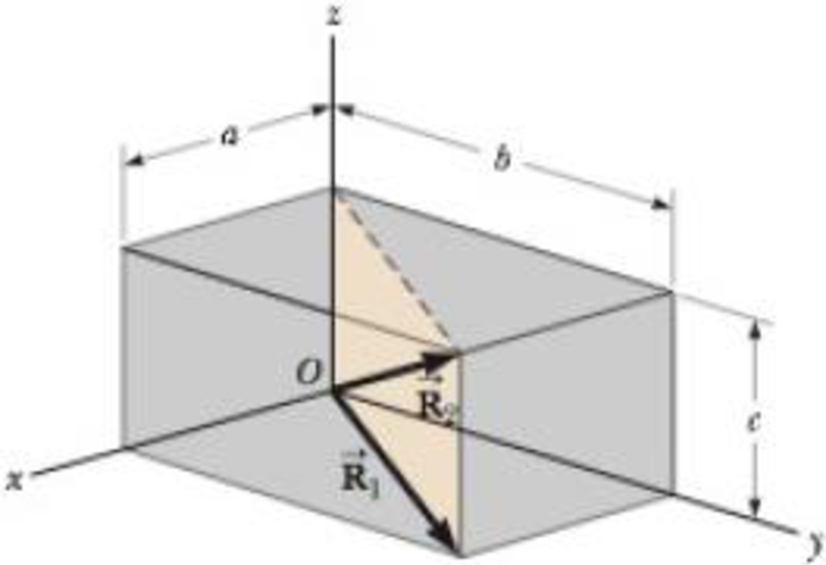
Concept explainers
A rectangular parallelepiped has dimensions a, b, and c as shown in Figure P3.45. (a) Obtain a vector expression for the face diagonal vector

Want to see the full answer?
Check out a sample textbook solution
Chapter 3 Solutions
Physics for Scientists and Engineers With Modern Physics
- What surface is represented by r a = const, that is described if a is a vector of constant magnitude and direction from the origin and r is the position vector to the point P(x1, x2, x3) on the surface?arrow_forwardA delivery man starts at the post office, drives 40 km north, then 20 km west, then 60 km northeast, and finally 50 km north to stop for lunch. Use the analytical method to determine the following: (a) Find his net displacement vector. (b) How far is the restaurant from the post office? (c) If he returns directly from the restaurant to the post office, what is his displacement vector on the return trip? (d) What Is his compass heading on the return trip? Assume the +x-axis is to the east.arrow_forwardConsider the three displacement vectors A=(3i3j)m, B=(i4j)m, and C=(2i+5j)m. Use the component method to determine (a) the magnitude and direction of the vector D=A+B+C and (b) the magnitude and direction of E=AB+C.arrow_forward
- A vector points from the origin into the second quadrant of the xy plane. What can you conclude about its components? (a) Both components are positive. (b) The x component is positive, and the y component is negative. (c) The x component is negative, and the y component is positive. (d) Both components are negative. (e) More than one answer is possible.arrow_forwardLet us name three perpendicular directions as right, up, and toward you as you might name them when you are facing a television screen that lies in a vertical plane. Unit vectors for these directions are r, u, and t, respectively. Consider the quantity (3u2t). (i) Is the magnitude of this vector (a) 6, (b) 3, (c) 2, or (d) 0? (ii) Is the direction of this vector (a) down, (b) toward you, (c) up, (d) away from you, or (e) left?arrow_forwardA Three vectors all have the same magnitude. The symbol for the magnitude of each of these vectors is M. The first vector A points in the positive x direction. The second vector B points in the negative y direction. The third vector C points in the positive z direction. These three vectors added together are equal to a fourth vector D. What is the magnitude of the fourth vector?arrow_forward
- Vector B has x, y, and z components of 4.00, 6.00, and 3.00 units, respectively. Calculate (a) the magnitude of B and (b) the angle that B makes with each coordinate axis.arrow_forwardA rectangular parallelepiped has dimensions a, b, and c as shown in Figure P3.45. (a) Obtain a vector expression for the face diagonal vector R,. (b) What is the magnitude of this vector? (c) Notice that R, ck, and R, make a right triangle. Obtain a vector expression for the body diagonal vector R2. b Ro R1 Figure P3.45arrow_forwardThe components of all the vectors are INTEGERS. Consider the two vectors, A and B, in the figure. What would be the x and y components of the the vector sum C = A + B?arrow_forward
- Question 13, Physics - equation sheet attachedarrow_forwardFind the vector projection of b in the direction of a: proj„b. Then, sketch proj„b on the diagram. You can reconstruct the diagram in your solution rather than scanning this page.arrow_forwardPosition vectors of two particles, A and B are given:A = 3i + 4j + 5k metersB = -4i + 2j - 7k metersVector C is the position vector of particle C that is the cross product of vectors A and B (C = A x B). Together, particles A, B, and C become vertices of a triangular plane in space. What is the perimeter of the triangle that is formed by the three particles? Position vectors of two particles, A and B are given:A = 3i + 4j + 5k metersB = -4i + 2j - 7k metersVector C is the position vector of particle C that is the cross product of vectors A and B (C = A x B). Together, particles A, B, and C become vertices of a triangular plane in space. What is the area of the triangle that is formed by the three particles?arrow_forward
 University Physics Volume 1PhysicsISBN:9781938168277Author:William Moebs, Samuel J. Ling, Jeff SannyPublisher:OpenStax - Rice University
University Physics Volume 1PhysicsISBN:9781938168277Author:William Moebs, Samuel J. Ling, Jeff SannyPublisher:OpenStax - Rice University Classical Dynamics of Particles and SystemsPhysicsISBN:9780534408961Author:Stephen T. Thornton, Jerry B. MarionPublisher:Cengage Learning
Classical Dynamics of Particles and SystemsPhysicsISBN:9780534408961Author:Stephen T. Thornton, Jerry B. MarionPublisher:Cengage Learning Principles of Physics: A Calculus-Based TextPhysicsISBN:9781133104261Author:Raymond A. Serway, John W. JewettPublisher:Cengage Learning
Principles of Physics: A Calculus-Based TextPhysicsISBN:9781133104261Author:Raymond A. Serway, John W. JewettPublisher:Cengage Learning Physics for Scientists and Engineers: Foundations...PhysicsISBN:9781133939146Author:Katz, Debora M.Publisher:Cengage Learning
Physics for Scientists and Engineers: Foundations...PhysicsISBN:9781133939146Author:Katz, Debora M.Publisher:Cengage Learning



